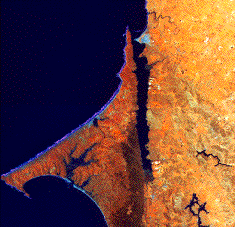
NASA ER-2 false color infrared photograph of Tomales Bay, California, and surrounding watershed. For scale, the bay is approximately 20 km in length and is oriented NW-SE. (NASA photo).
Click on the small pictures to see them at a larger size.
NASA ER-2 false color infrared photograph of Tomales Bay, California, and surrounding watershed.
For scale, the bay is approximately 20 km in length and is oriented NW-SE. (NASA photo).
Click on the small pictures to see them at a larger size.
In general, this section summarizes research accomplishments on this program, as reported to NSF.
Between 1985 and 1996, J. T. Hollibaugh and S. V. Smith were funded by NSF for the detailed analysis of carbon, nitrogen, and phosphorus cycling in a coastal ecosystem: Tomales Bay, California (BRIE, for "Biogeochemical Reactions in Estuaries"). Between 1989 and 1996 that study was funded as one of NSF's LMER (Land Margin Ecosystems Research) sites, under grants OCE 89-14833 and OCE 95-23466 (awarded to SVS) and grant OCE 89-14921 (awarded to JTH). The study has resulted (so far) in a total of approximately 65 papers and numerous invited and contributed presentations at national and international meetings. Four post-doctoral fellows, four Ph.D. students, 9 M.S. students, and about 10 undergraduate students received training on this project. More than 20 other investigators and collaborators were involved with the project. In the interest of space, this summary is kept short. References in this section are examples of outcomes from the study. A full reference list can be seen by clicking here.
A major aspect of the study was the integrated analysis of carbon, nitrogen, and phosphorus fluxes to and through the Tomales watershed (Smith et al., 1996; Fischer et al. in press), and through the bay (Smith et al., 1987, 1989, 1991; Smith and Hollibaugh, submitted). Both conservative (hydrological, hydrographic; Hearn et al., in press; Hearn and Largier, in press; Largier et al., in press) and nonconservative (within-system uptake, release) fluxes were considered. Estimates of flux included major metabolic components of the system (Dollar et al. 1991; Fourqurean et al., in press), as well as the total system metabolism.
Water exchange was estimated by means of water and salt budgets. Budgeting of C, N, and P fluxes was undertaken with the premise that uptake and release of phosphorus are largely controlled by net organic metabolism (primary production - respiration), scaled from P to C by the C:P ratio of organic matter in the system. Deviation of nonconservative N flux from a similar N:P scaling occurs because of nitrogen fixation - denitrification. Nonconservative alkalinity flux reflects net sulfate reduction, and deviations of dissolved inorganic carbon flux from C:P scaling reflect gas exchange across the air-sea interface.
Because this "stoichiometric analysis" is somewhat controversial, studies were undertaken to compare assay-based estimates of characteristics of material fluxes with the budgetary estimates (Joye, 1993; Joye et al., in press; Chambers et al., 1994, 1995). In this system, the budgetary estimates appear to be robust estimators of whole-system biogeochemical fluxes. Sediment diagenetic processes (Vink, 1994; Vink et al, in press; Popp et al., 1995; Rust, 1993; Christensen, 1995) are important aspects of nutrient dynamics in this system.
Time series sampling was undertaken to describe seasonal, annual, and interannual variations of fluxes over 8 years (1987-1995), and various monitoring data, hydrological models, and geochemical reconstruction (210Pb, 137Cs) were used to examine interannual to decadal variation back approximately 130 years (Rooney, 1995). Additional reconstruction using 14C dating and sediment biomarkers (13C, lignin oxidation products) further extended estimates of changes in sediment delivery associated with human activities in the watershed back 300 years (Plant, 1995). One interesting observation is that marine inputs of organic material seem largely to control both seasonal and interannual variations in the net heterotrophy, while terrigenous inputs are important in the long term mean heterotrophy. We interpret this difference to reflect the relative lability of the marine versus terrigenous inputs (Smith and Hollibaugh, submitted).
One of our conclusions (Smith and Mackenzie, 1987; Smith and Hollibaugh, 1993) has been that the ocean in general and many systems in the coastal ocean in particular tend to oxidize more organic carbon than they produce. Tomales is an example of this phenomenon (production: respiration ratio ( 0.9). This so-called "net heterotrophy" does not imply a low rate of primary production, but rather that respiration tends to exceed primary production. Work by other investigators, since our statement of this conclusion, seems to be generally bearing out the conclusion, although examples of net autotrophic systems exist. We have further suggested (Smith, 1995) that anthropogenic activities are tending to increase, rather than to decrease, this net heterotrophy globally. Another position which we have taken and which is now finding support is the idea (Smith and Hollibaugh 1989; Smith et al. 1978, 1991; Kimmerer et al. 1993) that carbon metabolism appears to control availability of nitrogen in the marine environment, largely as a result of the feedbacks of denitrification and nitrogen fixation .
The information described in this section represents a combination of accumulated historical knowledge about Tomales Bay and research undertaken during this program.

This page was last updated by SVS April 13, 1998.
Maintained by Stephen V. Smith at svsmith@soest.hawaii.edu